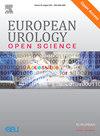与阴茎癌手术相关的早期和晚期并发症和人乳头瘤病毒状态的影响:来自挪威回顾性队列研究的结果
IF 3.2
3区 医学
Q1 UROLOGY & NEPHROLOGY
引用次数: 0
摘要
背景与目的阴茎癌(PeCa)和阴茎上皮内瘤变(PeIN)是一种罕见的疾病,手术相关并发症的负担仍未得到充分报道。目的是评估早期(≤30 d)和晚期(≤30 d)并发症以及人乳头瘤病毒(HPV)状态的影响。方法回顾性分析2000年1月1日至2023年12月31日期间在某三级中心作为集中区域服务的一部分接受手术(保留阴茎,部分和全部截肢)的201例连续和treatment-naïve例PeCa/PeIN患者的队列。主要发现和局限性中位随访时间为39个月(四分位数范围21,76)个月。患者早期和晚期并发症发生率分别为45%和38%。其中,18.5%的患者经历了两种或两种以上的早期并发症。大多数(80%)的早期并发症是轻微的(Clavien-Dindo≤2)。重症监护病房的入院率为1%,但30 d内无死亡记录。体重指数(BMI)是早期并发症的重要预测因子(p = 0.01)。晚期并发症包括慢性伤口刺激(10%)和尿道狭窄(11%)。后者在部分截肢者中最高。1 / 4的患者在随访期间因复发而再次手术。HPV状态与早期或晚期并发症的发生率无关。结论及临床意义特殊外科手术在术后早期和后期都有较高的并发症负担。淋巴结手术进一步增加了发病率。BMI是早期并发症的重要预测指标,而HPV状态不影响早期或晚期并发症的发生率。阴茎癌手术在术后早期和后期并发症发生率高。然而,大多数并发症并不严重。体重指数是早期并发症的重要预测指标,但人乳头瘤病毒状态与并发症的风险无关。本文章由计算机程序翻译,如有差异,请以英文原文为准。
Early and Late Complications Associated with Penile Cancer Surgery and the Impact of Human Papillomavirus Status: Findings from a Retrospective Norwegian Cohort Study
Background and objective
Penile cancer (PeCa) and penile intraepithelial neoplasia (PeIN) are rare diseases, and the burden of complications associated with surgery remains under-reported. The objective was to evaluate the early (≤30 d) and late (>30 d) complications and the impact of human papillomavirus (HPV) status.
Methods
A retrospective analysis was conducted of a cohort consisting of 201 consecutive and treatment-naïve patients with PeCa/PeIN undergoing surgery (penile sparing, and partial and total amputation) between January 1, 2000 and December 31, 2023 at a tertiary centre as part of a centralised regional service.
Key findings and limitations
The median follow-up time was 39 (interquartile range 21, 76) mo. The early and late patient complication rates were 45% and 38%, respectively. Of the patients, 18.5% experienced two or more early complications. A majority (80%) of early complications were minor (Clavien-Dindo ≤2). There was a 1% admission rate to the intensive care unit, but no deaths were recorded within 30 d. Body mass index (BMI)was a significant predictor of early complications (p = 0.01). Late complications included chronic wound irritation (10%) and urethral stricture (11%). The latter was highest among those who had undergone partial amputation. One in four patients underwent reoperation due to recurrence during follow-up. HPV status had no association with the rate of either early or late complications.
Conclusions and clinical implications
PeCa surgery is associated with a relatively high complication burden, in both the early and the late postoperative period. Lymph node surgery further adds to the morbidity profile. BMI was a significant predictor of having an early complication, while HPV status did not affect the rate of early or late complications.
Patient summary
Penile cancer surgery is associated with a high rate of complications in early as well as late postoperative period. However, most of these complications are not severe. Body mass index was a significant predictor of an early complication, but human papillomavirus status was not associated with the risk of complications.
求助全文
通过发布文献求助,成功后即可免费获取论文全文。
去求助
来源期刊

European Urology Open Science
UROLOGY & NEPHROLOGY-
CiteScore
3.40
自引率
4.00%
发文量
1183
审稿时长
49 days
 求助内容:
求助内容: 应助结果提醒方式:
应助结果提醒方式:


